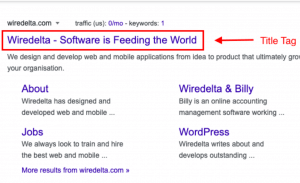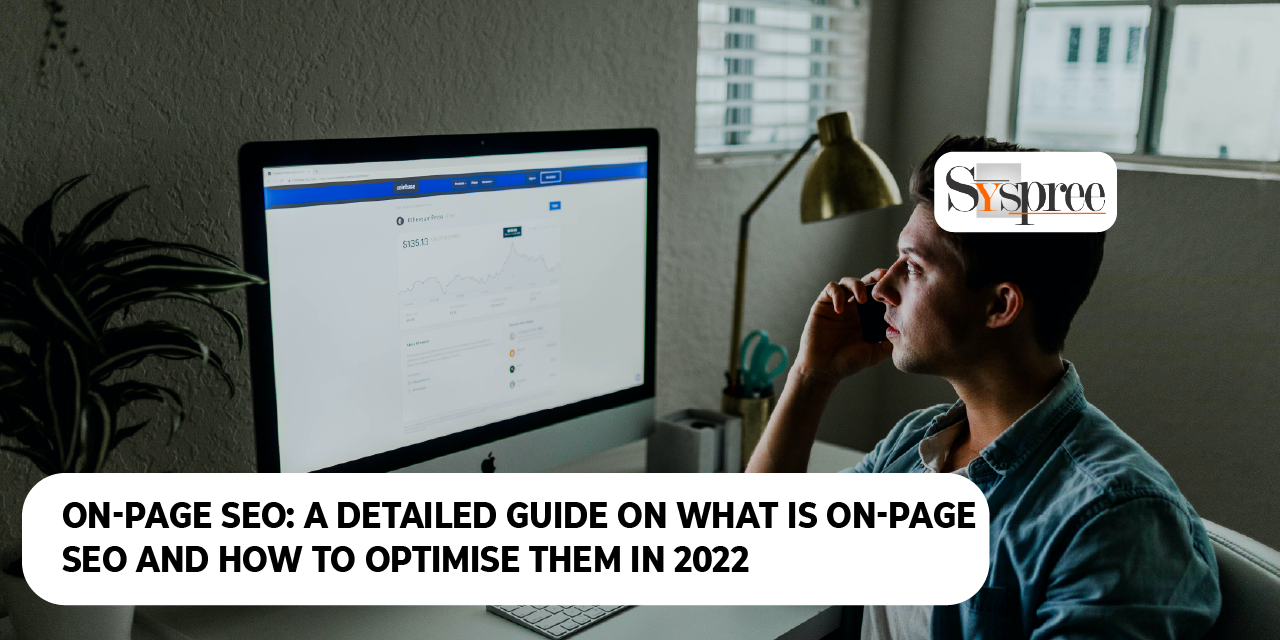In the present era, digitally boosting your business is a tough challenge. As the top SEO Company in Mumbai, we know that It involves building a business website with all the necessary elements of an SEO-friendly website to help it rank at the top of the search engine results page or commonly known as SERP.
It might be even more complicated if you are a beginner in this field. But we have got you. With our guide for on-page SEO, you will be ready to run a successful website.
Key Takeaways
- On-page SEO refers to optimizing web pages and content to improve visibility on search engine results pages (SERP).
- On-page SEO is important to ensure that a website appears on the first page of search results and is relevant to the search query.
- To use on-page SEO techniques effectively, use relevant keywords in the content, use keywords a few times but avoid keyword stuffing, have precise URLs, optimize title tags, write persuasive meta descriptions, and optimize alt tags for images.
- Keywords are crucial in on-page SEO and need to be used in the content and title tags for relevance.
- On-page SEO elements, such as URL structure, title tags, meta descriptions, and alt tags, need to be updated regularly to provide accurate information and improve search engine positioning.
What is On-Page SEO?
On-page SEO, also known as on-site SEO, includes optimizing the web pages and all the content for the search engines. These additions are made to the web pages to improve their visibility and appear at the top of the organic search results.
A Digital Marketing Agency in Mumbai understands that creating an effective on-page SEO web page includes optimizing the content, title tags, URLs, images, internal links, voice search, and several other aspects that need consideration to have an on-page SEO website.
On-page SEO is a lot different from off-page SEO, which deals in optimizing the various aspects of the website like the backlinks etc.
What is the need for On-page SEO?
The main reason why on-page SEO is considered crucial is that on-page SEO optimization helps the website appear on the first page of search results and at the top of it.
Google has upgraded its search engine performance over the last decade and continues to do the same so that the search query gets the most appropriate and relevant results for it. And to make sure that your website is relevant to the search, you have to ensure that you are acing the on-page SEO game.
When it is perfect, it will increase the user experience making Google aware that your content is relevant to the search result, helping your positioning in the search results.
Now that you understand on-page SEO and the reasons why it is necessary for your website, let us take a look at the ways it should be optimized.
How to use on-page SEO techniques to get better rankings on search results?
1. Make use of relevant keywords on your web page.
Using keywords that are relevant and appropriate material to the content is beneficial, as they provide information about your website and its content to the search engine. The search engine can then rank your web page according to its relevance.
Google has come a long way with its search algorithm. However, it still relies heavily on keyword matching to show results.
A web page is most relevant when it has keywords in its content or title that are the same as the search query and will most likely appear on the first page.
2. Frequency of the keywords.
Keywords are something that can make or break your SEO strategy. The number of times you use a particular keyword in your content will determine if Google sees your web page as relevant or not.
When you use a keyword just once, it will not do any good for your website as Google needs to know if your website is appropriate to the search. It will happen if the keywords are mentioned a few times on the web page.
On the other hand, keyword stuffing can do the opposite of the above. Keyword stuffing happens when a keyword is used forcefully in the content so often that the content is seen and considered spam. Adding a keyword just for the sake of it in high numbers will hurt your rankings.
3. Keep the page URLs precise.
According to Google Search Central, the structure of the URL should be as simple as possible. It should be short and not consist of long series of numbers, so it is easily readable.

Using precise URLs – On-page SEO strategy
According to experts from the leading Digital Marketing Agency in Mumbai, another important factor would be to create a URL using keywords that increase its chances of being a relevant website. Adding hyphens to break the words in the URLs helps the algorithms to comprehend them.
Optimizing the page URLs may not sound very important, but it is. Making your URL SEO-friendly will reward your efforts with better positioning.
4. Optimizing your title tags.
A title tag is an HTML code that lets you add a title to your web page. A title tag is displayed on the search engine results page or commonly known as SERP, that takes you to the website when clicked.

Optimizing Title Tag – On-page SEO strategy
The main thing to do while creating a title tag is to keep it concise and descriptive. Do not go overboard and include a lot of words. Using keywords in the title tag can be favourable.
The content on the web page is regularly updated to provide accurate answers, but the title tag must also be updated when needed.
5. Write persuasive meta descriptions.
Meta descriptions are a summary of the content provided on your web page. The text snippet is under the headline of the web page that appears in the search engine result page (or SERP). It gives the user an insight into what they can expect from the web page.
Each web page must have a meta description describing the web page. Having a unique meta description for a different web page is necessary, as having the same descriptions everywhere will not be helpful.
Meta descriptions are supposed to describe in detail, so wherever necessary, you must make them short and accurate.
6. Optimize the Alt tags
The images used in the web pages can easily be seen and understood by people. The same does not apply to search engines and other bots.
The alt tags, also known as alt attributes or alt descriptions, help the search engines to decipher the images and make sure that they understand them.
Experts from the top SEO Company in Mumbai, suggests that the best way to optimize the alt tags is to keep them precise and less wordy. Refrain from stuffing the tags with keywords as excessive use of keywords will be considered spam.
Use keywords on the web pages that are heavily filled with images and use shorter texts.
7. Optimization of the images
Image optimization is one of the essential factors as it can help in the load time and the ranking in the search results.
To get the best result, make sure to keep the size of the image file as low as possible, and while doing so, maintain the quality of the image. The larger the size of the file, the longer it takes the web page to load.
Choose the correct file size for your images. Commonly used files are JPEG, PNG, and GIF. But for better quality and smaller file size, it is suggested that you use JPEG.
And lastly, as mentioned earlier, optimize your alt tags. Refrain from adding lengthy alt tags. Aim for short and descriptive.
8. Add internal and external links to your page.
Including external and internal links to your web page has its benefits. Internal links are the links that take the user from one page to other pages of your website.
They allow the users to explore the different web pages of your website and provide a positive user experience.
External links, on the other hand, are the links that take users to a different website that is reputable.
Now it might be strange to drive the users away from your website, but they are valuable, as these links make your website seem reputable and relevant too.
9. Create compelling and user intent content
The user intent is also known as the search intent, and it shows you the intention of the search carried out by the user.
User intent is always either one of these- commercial, informational, navigational, or transactional. It is necessary to have one of these in your content to satisfy the user’s intent.
When the content has answered exactly what the user wants, it will enhance the user experience and complete its goal of providing the right content.
Search engines strive to give the users what they need and when they know that your web page is providing what the searchers want, the search engines will push your web page to the top of the search engine result page (SERP).
10. Generate SEO rich content
It is one of the main factors, but many fail to implement it correctly. SEO-rich content will ensure that the search engines see that your content is worthy enough to be shown at the top of the search results.

Generate SEO rich content – On-page SEO strategy
SEO-rich content will have suitable keywords with the proper amount of them distributed on the web page.
Producing high-quality content that pleases the reader. Creating content that gives an excellent user experience will signal the search engines about the quality and relevance of your web page.
11. Make use of the main keyword in the first 100 words.
This technique has been in use for a long time, and this is because it is one of the old tricks that still work.
Using keywords in the first 100 or 150 words is necessary, as the search engines consider the web pages which have the appropriate keywords at the beginning of the content.
It makes sense because why would the search engine consider the web page if the main keyword is at the bottom of the page.
To explain it in an example, if you are putting out content related to gaming laptops, it might make more sense to use gaming laptops in the beginning?
12. Write content for humans.
When optimizing your website and creating content to ensure that search engines acknowledge it, keep in mind that the content is to be consumed by human users.
If the users reading it will not understand the writings, it will be of no use. And it will result in low rankings on the search results page.
To avoid such disasters in the future, keep in mind that the sentences need to be framed and correctly structured while avoiding jargon that will confuse the readers. The content should be easy to read and understand.
13. SEO for voice search
Voice search is one of the fastest-growing functions today. According to a survey, more than 50% of internet users use voice search from their smartphones.
The numbers are growing even today, and this is a chance for all businesses to utilize voice search to get in the search results. Marketers need to focus on devices used for voice search.
As keywords used in voice search differ from written searches, you need to focus on conversational keywords.
When using voice search, people usually ask queries that require quick answers. The best way to answer them is to set up FAQ pages that provide quick answers to common questions.
14. Responsive web design
Have you ever come across a website that was annoyingly large for your smartphone and just will not fit on your screen? Do not let that happen to your website.
Responsive web design is a way to ensure that your website can adapt to any device (smartphone, tablet, desktop, etc.).

Responsive Web Design – On-page SEO strategy
When a web page does not adapt to the user’s device, they will not consume the content in such a poorly made web page. It will automatically signal the search engines that your web page is not relevant, dropping your rankings.
You do not want to be in that situation, so to avoid that nightmare build a website that can adapt to any device.
15. Reduce the load time of your page
A web page that takes forever to load is one of the most annoying things a user can face. It is also one of the reasons for increasing the bounce rates.
To optimize the speed of the page, make sure to compress the images on your web page without sacrificing their quality.
Eliminate unnecessary plugins that might slow down your web page.
Try to avoid redirects, as adding those increases the HTTP coding and the load on the web page.
Best practices for keyword research and selection
Keyword research and selection are critical components of a successful on-page SEO strategy. To ensure that your website is ranking for the right keywords, it is important to follow best practices for keyword research and selection. Firstly, start by defining your target audience and identifying the keywords they use to search for products or services related to your business.
Secondly, use tools such as Google Keyword Planner, SEMrush or Ahrefs to analyze the search volume, competition level and relevance of keywords. Thirdly, select keywords that are relevant to your business, have a high search volume and low competition. It is also important to keep track of your target keywords’ performance and make adjustments as necessary. Furthermore, don’t forget to diversify your keyword portfolio by including long-tail keywords, local keywords and question-based keywords. By following these best practices, you will be able to find and target the right keywords to improve your website’s ranking and drive more traffic.
Conclusion:








Beneficial and informative blog! It has everything you need to know about On-Page SEO. The language used is simple and easy to understand, and it is also very detailed at the same time.
Appreciate the efforts taken.
Thank you for sharing your views with us.
Everything to know about On-Page SEO is here! it’s like the perfect guide for everyone. Thank you for such an informative blog.
Thank you for your kind feedback.